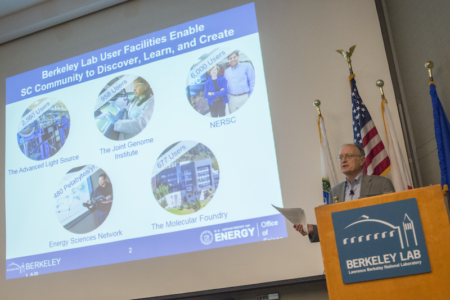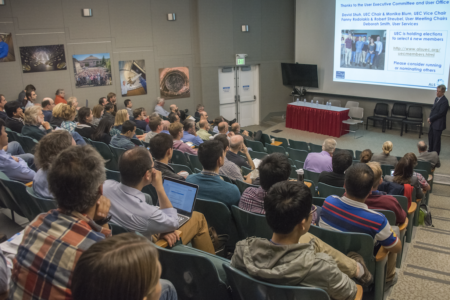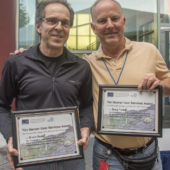
About 400 ALS users came together at the beginning of the month for the annual ALS User Meeting. Attendees listened to colleagues present their research, took part in scientific workshops, interacted with exhibitors, and recognized this year’s awardees.
ALS Users’ Executive Committee (UEC) Co-Chair Monika Blum launched the meeting with the introduction of Berkeley Lab’s new director, Mike Witherell. Speaking on strategic initiatives key to the Lab’s future, Witherell named the ALS Upgrade (ALS-U) the most important, calling it a “big leap for scientific potential with a modest investment.” He also announced that ALS-U had recently achieved a critical milestone in the Department of Energy approval process—critical decision zero (CD-0), also known as mission need approval. (See the complementary article on ALS-U at the User Meeting for more details.)

ALS Director Roger Falcone echoed Witherell’s sentiments as he presented his annual update. Outlining the current ALS beamline projects, Falcone pointed out that advancing techniques both prepares us for an upgrade and gives users an excellent path to further their research in the short and long term. Falcone reported that ALS user numbers and publications have continued to grow, with 20 percent of user publications in high-impact journals. Beamline 7.3.3 received special recognition, with more than 100 publications this year. Falcone encouraged users to take advantage of the strong partnership the ALS has with Berkeley Lab’s Molecular Foundry facility and to make use of the collaborative application process that’s available for users of both facilities.
Jeff Neaton, director of the Molecular Foundry, presented more details on the opportunities available to ALS users at the Foundry. Just a 10-minute walk from the ALS, the Foundry offers advanced electron scattering and imaging, theory, and analysis that complement the techniques at the ALS. Neaton presented highlights from a selection of high-impact publications that all involved ALS users and a review of new instruments and expertise that have been introduced at the Foundry over the past year.
Carolyn Larabell, Director of the ALS National Center for X-ray Tomography (NCXT), took the stage to speak about imaging complex biological systems with soft x-ray tomography. Larabell presented research examples and images from her many years at the ALS, showing users the unique views that synchroton imagery gives of whole cells.
UC Berkeley Senior Faculty Scientist Jeffrey Long spoke to users about natural gas storage in metal-organic frameworks (MOFs) and how it’s used for boosting natural gas storage in car fuel systems. In researching ways to increase driving range in natural gas cars, the search for new materials that can serve as absorbents in natural gas systems is key. Long and his team have used the ALS to gain insights, and see ALS-U helping to give a much greater advantage in following the kinetics of these systems.
Stanford’s Zhi-Xun Shen spoke about boundaries of quantum systems in condensed matter physics, stressing that our entire societal infrastructure is based on electricity, so understanding conductivity is important. Shen pointed out that the understanding and control of conductivity has been a remarkable driver for scientific discoveries and technological breakthroughs, and ALS-U will continue to drive this forward.
ALS staff updates included User Services Group Leader Sue Bailey, who highlighted new offerings to enhance the user experience. These include ALS Scheduler, a new tool for centralized scheduling of beamlines, which will soon be broadly available, and the Experiment Safety Approval Form system, expected to be rolled out by early spring. The User Office is also asking all beam time applicants to provide an ORCID ID (a unique, free identifier for researchers, analogous to the DOI for publications) and is working to improve the transfer of proposals requesting joint access to the ALS and Molecular Foundry. ALS-U Project Director Dave Robin and ALS Science Deputy Steve Kevan provided details on plans for ALS-U and opportunities for user engagement.

Tuesday afternoon also featured the user town hall, with opportunities for users to speak directly with ALS management, and the lively ALS Student Poster Slam, which gives recognition to significant student research conducted at the ALS. Twelve students presented their posters on a wide variety of topics, with first prize going to Norwegian University of Science and Technology’s Ingrid Hallsteinsen, for her poster “Induced Ferromagnetism at the Interface of Complex Oxides.” Second and third prizes went to Rebecca Siegelman and Michael Tuchband, respectively. Hallstein spoke Tuesday morning about her research; she uses the ALS to do magnetic spectroscopy to look for ferrimagnetism and electron microscopy to image domain structure.
ALS Beamline Scientist Eli Rotenberg opened the Tuesday session with a presentation about the new MAESTRO beamline, which was designed for 30,000 resolving power, which testing has already shown to be achieved. The new beamline offers a PEEM microscope and three complementary ARPES (angle-resolved photoemission spectroscopy) chambers, with a spot size five times better than before. Rotenberg mentioned that there is currently plenty of RAPIDD access beam time available at MAESTRO.
Google’s Chris Roat spoke to users about how Google’s accelerated science team can help them manage their data by bringing Google capabilities to scientific research. Longtime ALS users Cheryl Kerfeld and Brandy Toner rounded out Tuesday morning’s speaker series with presentations about insights gained from their ALS research.


Tuesday evening featured the annual ALS Awards banquet. This year’s David A. Shirley Award for Outstanding Scientific Achievement at the ALS went to Tolek Tyliszczak for “outstanding creativity in diverse scientific disciplines requiring novel soft x-ray microscopy approaches.” The Klaus Halbach Award for Innovative Instrumentation at the ALS was awarded to Eli Rotenberg, Aaron Bostwick, Chris Jozwiak, Geoff Gaines, and Roland Koch for the development of the MAESTRO endstation suite, which “integrates nanoscopic photoemission with a full suite of analysis tools and materials growth facilities for studying the relationship between morphology and electronic structure for in-situ grown samples.” The Tim Renner User Services Award for Outstanding Support to the ALS User Community was awarded to Bruce Rude for “outstanding commitment and attention to detail in providing excellent and unique instrumentation and support to ALS users” and to Doug Taube for “maintaining an outstanding standard of safety for our users and for defining what it means to be a true friend of the ALS user community.”